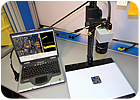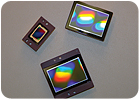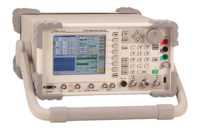
In designing an industrial machine vision system, one of the most important decisions is whether to use a digital or analog camera. Each has advantages and limitations. But in the final analysis, the choice will be based on cost and certain key operating factors. When these factors are considered, one technology or the other will emerge as the clear favorite.
Machine Vision Basics
Machine vision is used in automated quality inspection, process control, parametric measurement and automated assembly. In these systems, the camera is the key component that controls cost, speed and accuracy. Both analog and digital cameras can be used in these systems, and understanding camera specifications and their importance in various vision tasks is an essential step toward applying machine vision to industrial control.Machine vision systems have three main elements: camera, frame grabber and computer (or image processor) that hold the images in memory and manipulate the images to extract information. The image processor and frame grabber are relatively straightforward electronic devices whose main parameters are memory depth and processing speed.
The most complex element of these systems is the camera. Modern analog and digital cameras use charge-coupled devices (CCDs) or complementary metal-oxide semiconductor (CMOS) chips to capture the image and generate an electrical signal that is sent to a computer for processing.
CCD and CMOS imagers comprise an array of square photosensitive cells that convert incoming photons to electrons and accumulate the resulting charge. In CCD the charge is converted to voltage one pixel at a time as they are read from the chip. In CMOS circuitry next to each photosensor converts light energy to a voltage.
Neither technology has a clear advantage in image quality. CMOS-based cameras require fewer components, use less power and provide data faster than CCD-based units. CCD is a more mature technology that provides better image quality with less noise, but the downside is slower data transfer rate, less flexibility, more components and higher power consumption.
Signal Accuracy
Internally, both CCD and CMOS chips generate an analog signal, therefore, the key difference between analog and digital cameras is where the image is digitized. Digital cameras digitize the signal in the camera and transmit it digitally to the computer (or image processor) via serial bus interfaces such as FireWire, USB, CameraLink or Gigabit Ethernet. Analog camera systems, on the other hand, do not digitize the image signal internally-this is done at the computer-so the analog information is transmitted via a coaxial cable.While both methods can be effective, analog signals can degrade due to electromagnetic interference from other equipment in the factory such as electric motors or high voltage cables. As noise level increases, the dynamic range-the original signal divided by the noise-of analog cameras drops. Dynamic range determines how much information can be transmitted from the camera to the computer.
Digital signals are immune to electrical noise; therefore, digital cameras have a higher dynamic range and transmit a more accurate signal to the computer. Typical dynamic range for digital cameras is 55 to 60 dB while that for analog cameras is about 45 to 50 dB.
The length and type of cabling used also affects signal accuracy. Analog camera cabling is simple and inexpensive, and can transmit a reliable signal for more than 300 meters before electrical noise degrades the signal too much. Because digital cameras transmit a high bandwidth signal, cable lengths are limited by the amount of attenuation (loss) in the cable. Depending on the communications protocol used, typical cable limits are:
• FireWire – about 10 to 20 meters
• USB – about 10 to 20 meters
• CameraLink – about 10 meters
However, newer systems are coming on the market based on Gigabit per second Ethernet standard cables. These cables can transmit digital image data without loss for about 100 meters.

Resolution and Capture Speed
One of the primary parameters describing a camera is resolution, which consists of two components:• Number of sensing element, or pixels, in the array
• Size of each sensing element
Analog cameras are generally based on the Video Graphics Array (VGA) image format, which limits resolution to about 640 by 480 pixels. This represents the lower limit of machine vision requirements. Digital cameras, on the other hand, can provide resolutions as high as 80 megapixels or more. Element size for both analog and digital cameras is typically 3 to 20 microns on edge.
A second key parameter is frame rate, or the speed at which the camera can deliver successive images. The higher the frame rate, the more inspections, measurements or identifications can be made in a given time. Pixel count and frame rate are intertwined so the more pixels a camera offers, the slower its frame rate. However, this is not a hard-and-fast rule because finer geometry semiconductors usually provide faster shift rates, so two cameras of the same pixel count could have significantly different frame rates.
The typical frame rate for 640 by 480-pixel analog cameras is 30 frames per second. Digital cameras can provide this same frame rate with a resolution of 2 megapixels (1,600 by 1,200 pixels). Digital cameras rated for 16 megapixels provide frame rates of about 3 frames per second.
Also, camera sensors can be designed with multiple ports, breaking the image into sections for simultaneous readout. It also is possible under software control to read only a particular “area of interest” in the image rather than the full sensor array, reducing transfer time.
Other Factors
Besides resolution and frame rate, other important design factors include dynamic range and sensitivity.Dynamic range or number of bits per pixel for the image controls the memory size needed for the frame grabber as well as the arithmetic precision needed in the image processor. It also impacts the sensor’s exposure latitude. Cameras with only a few bits per pixel will not support as wide a range of lighting conditions as cameras offering more bits. Usually, digital cameras have better dynamic range because of their better noise immunity.
Sensor sensitivity also dictates the lighting conditions required for the camera to operate reliably. Low light or the need for fast shutter speeds to eliminate motion-related image blurring requires a more sensitive camera.
The camera’s wavelength-dependent sensitivity also may be important. Depending on the application, LED or even infrared or ultraviolet lighting may be needed, and the camera’s wavelength sensitivity should match. Finally, a camera’s ability to produce color or monochrome images can be important.
Consider All Costs
The various design parameters interact to dictate camera cost. Typically, larger pixel-count cameras are more expensive because of the sensor’s size. Similarly, faster frame rates for a given resolution tend to increase costs. Providing both high frame rates and high resolution usually requires cameras with multiport readouts, which increase costs because of the added system complexity.Analog cameras based on CCD and CMOS technology have been available since the 1970s from a variety of suppliers. They typically cost about $200. Frame grabbers for analog cameras also cost about $200.
Digital cameras, on the other hand, can range from $1,000 to $20,000. A frame grabber for a digital camera can cost anywhere from $1,000 to $2,000. However, digital cameras and frame grabbers are becoming more widely available, and their prices are dropping.
In comparing costs, however, the price of the equipment is only part of the story. Designers must also consider installation, software, hardware, maintenance and upgrade costs, and whether or not a given camera technology will provide the required performance.
Part of the installation cost is the number of cameras needed for a particular task. For example, resolving a 1-micron square from an inspection area of 1-millimeter square may require the use of five analog cameras and frame grabbers, which then must be synchronized to obtain a clear image.
The same area can be resolved using a single digital megapixel camera and frame grabber without the need to synchronize several images in the computer. As an example, a bumper inspection system for an auto manufacturer required 12 analog cameras, 12 frame grabbers with 12 copies of the software, and three computers. The company found it difficult, if not impossible, to synchronize the images from all the cameras to obtain a reliable image of the bumper. This array of cameras was replaced by a single digital megapixel camera, one frame grabber and one computer that were all simpler to install and easier to maintain.
As a rule, digital cameras typically require more time to install and set up, but applications such as those described above require far fewer digital cameras. Thus, maintenance costs will be significantly lower. In addition, digital cameras offer more features and more flexibility, and they can be reprogrammed on the fly, with firmware being upgraded in the field while the system is operating. Analog cameras, on the other hand, must be returned to the manufacturer to upgrade performance.
A final cost consideration is power usage. A typical analog camera requires about 5 to 10 W to operate vs. less than 1 W for an equivalent digital camera based on similar resolutions.

Application Requirements
Selecting the correct camera for an application depends on what the machine vision system is trying to achieve. Three common functions are visual inspection, contactless measurement, and object identification and orientation. Each has different requirements.Inspection systems typically compare an image to a template or “known good” image to identify variations. A high-quality image often is required for the image processor to make reliable comparisons. This means that the camera must offer both high resolution and many bits per pixel. Color capability also may be required.
Contactless measurement systems count the number of pixels an object occupies and translate that count into a dimensional value. High resolution may be required in such systems but bits per pixel may not need to be as high. Often, the image processor extracts only edges or outlines from the image, so wide dynamic range and color are not typically needed.
Object identification and orientation has varying requirements. In many cases, the image processing system seeks to identify reference marks in the image. The resolution required depends on the size of these marks relative to the overall image size. Identification systems also may require color image capability.
Choosing a camera for a machine vision system involves careful consideration of camera performance as well as cost. While analog cameras are considerably less expensive, they have lower resolution and image quality, so they may be limited to less demanding applications. Digital cameras are more expensive, but their higher cost may be justified for applications requiring speed, precision and higher accuracy. V&S
